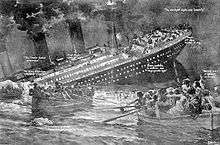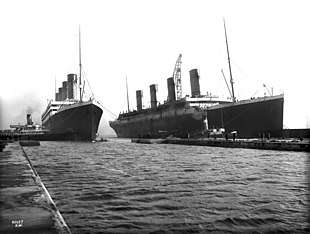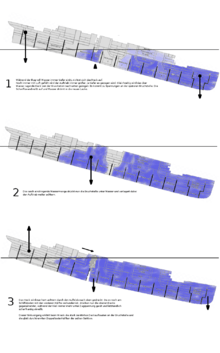Titanic conspiracy theories
The sinking of the RMS Titanic in 1912 shocked the world, and attracted so much controversy that a number of conspiracy theories have been put forward regarding the disaster.

One such theory is that the sunken ship was actually the Titanic's near-identical sister-ship Olympic, which was the subject of a large insurance claim, and that the two vessels were secretly switched prior to the voyage. Another is that the Titanic's owner, J.P. Morgan, wanted to eliminate several prominent bankers who were opposing his plan for the creation of a U.S. central bank.
Accepted version
The Titanic struck an iceberg, damaging the hull's plates in her starboard side causing her front compartments to flood below the water line. The ship then sank, causing about 1500 fatalities.
Olympic exchange theory
One of the most controversial[1][2] and elaborate theories surrounding the sinking of the Titanic was forwarded by Robin Gardiner in his book, Titanic: The Ship That Never Sank?[3] Gardiner draws on several events and coincidences that occurred in the months, days, and hours leading up to the sinking of the Titanic, and concludes that the ship that sank was in fact Titanic's sister ship Olympic, disguised as Titanic, as an insurance scam by her owners, the International Mercantile Marine Group, controlled by American financier J.P. Morgan that had acquired the White Star Line in 1902.

Olympic was the slightly older sister of Titanic, built alongside the more famous vessel but launched in October 1910. Her exterior profile was nearly identical to Titanic, save for minor details such as the number of portholes on the forward C decks of the ships, the spacing of the windows on the B decks, and the forward section of the A deck promenade on Titanic that had been enclosed only a few weeks before she set sail on her ill-fated maiden voyage. Both ships were built with linoleum floors, but shortly before she was due to set sail J. Bruce Ismay, managing director of the White Star Line, inexplicably ordered the floors aboard Titanic carpeted over.
On 20 September 1911, the Olympic was involved in a collision with the Royal Navy Warship HMS Hawke in the Brambles Channel in Southampton Water while under the command of a harbour pilot. The two ships were close enough to each other that Olympic's motion drew the Hawke into her aft starboard side, causing extensive damage to the liner – both above and below her waterline (HMS Hawke was fitted with a reinforced 'ram' below the waterline, purposely designed to cause maximum damage to enemy ships). An Admiralty inquiry assigned blame to the Olympic, despite numerous eyewitness accounts to the contrary.
Gardiner's theory plays out in this historical context. Olympic was found to be at blame in the collision (which, according to Gardiner, had damaged the central turbine's mountings and bent the keel, giving the ship a slight permanent list to port). Because of this finding, White Star's insurers Lloyd's of London allegedly refused to pay out on the claim. White Star's flagship would also be out of action during the extensive repairs, and the Titanic's completion date, which was already behind schedule due to Olympic's return to the yard after her loss of a propeller blade, would have to be delayed. All this would amount to a serious financial loss for the company. Gardiner proposes that, to make sure at least one vessel would be earning money, the badly damaged Olympic was patched up and then converted to become the Titanic. The real Titanic when complete would then quietly enter service as the Olympic.
The Titanic indeed had a list to port leaving Southampton. Inadequate trimming of cargo and bunkers would likely result in such and the crew seems to have demonstrated a lack of proficiency on several occasions. A list to port was noted by several Titanic survivors including Lawrence Beesley who wrote in his book about the sinking: "I then called the attention of our table to the way the Titanic listed to port (I had noticed this before), and we watched the skyline through the portholes as we sat at the purser's table in the saloon." (The dining saloon windows were double rows of portholes covered on the inside with screens of leaded decorative glass with no clear view of the outdoors.) This was echoed by survivor Norman Chambers, who testified that after the collision: "However, there was then a slight list to starboard, with probably a few degrees in pitch; and as the ship had a list to port nearly all afternoon, I decided to remain up."
Gardiner states that few parts of either ship bore the name, other than the easily removed lifeboats, bell, compass binnacle, and name plates. Everything else was standard White Star issue and was interchangeable between the two ships, and other vessels in the White Star fleet. While all other White Star Line Ships had their names engraved into their hulls, the Titanic alone had her name riveted over the top.
The Olympic had allegedly been damaged beyond economic repair. Gardiner suggests that the plan was to dispose of the Olympic in a way that would allow White Star to collect the full insured value of a brand new ship. He supposes that the seacocks were to be opened at sea to slowly flood the ship. If numerous ships were stationed nearby to take off the passengers, the shortage of lifeboats would not matter as the ship would sink slowly and the boats could make several trips to the rescuers.
Gardiner points to the length of Titanic's sea trials as evidence. Olympic's trials in 1911 took two days, including several high speed runs, but Titanic's trials reportedly only lasted for one day, with (Gardiner alleges) no working over half-speed. Gardiner says this was because the patched-up hull could not take any long periods of high speed. Perhaps this was due to the fact that Titanic as a nearly identical twin sister of the Olympic was expected to handle exactly the same, or perhaps the Board of Trade inspectors were in on the scheme.
Gardiner maintains that on 14 April, First Officer Murdoch (who was not officially on duty yet) was on the bridge because he was one of the few high-ranking officers other than Captain Smith who knew of the plan and was keeping a watch out for the rescue ships. One of Gardiner's most controversial statements is that the Titanic did not strike an iceberg, but an IMM rescue ship that was drifting on station with its lights out. Gardiner based this hypothesis on the idea that the supposed iceberg was seen at such a short distance by the lookouts on the Titanic because it was actually a darkened ship, and he also does not believe an iceberg could inflict such sustained and serious damage to a steel double-hulled vessel such as the Titanic.
Gardiner further hypothesises that the ship that was hit by the Titanic was the one seen by the SS Californian firing distress rockets, and that this explains the perceived inaction of the Californian (which traditionally is seen as failing to come to the rescue of the Titanic after sighting its distress rockets). Gardiner's hypothesis is that the Californian, another IMM ship, was not expecting rockets but a rendezvous. The ice on the deck of the Titanic is explained by Gardiner as ice from the rigging of both the Titanic and the mystery ship she hit. As for the true Titanic, Gardiner alleges that she spent 25 years in service as the Olympic and was scrapped in 1935.
Researchers Bruce Beveridge and Steve Hall took issue with many of Gardiner's claims in their book, Olympic and Titanic: The Truth Behind the Conspiracy.[1] Author Mark Chirnside has also raised serious questions about the switch theory.[2]
Closed watertight doors
Another theory involves Titanic's watertight doors. This theory suggests that if these doors had been opened, the Titanic would have settled on an even keel and therefore, perhaps, remained afloat long enough for rescue ships to arrive. However, this theory appears to be far from reality for two reasons: first, there were no watertight doors between any of the first four compartments, thus it was impossible to lower the concentration of water in the bow significantly. Second, Bedford and Hacket have shown by calculations that any significant amount of water aft of boiler room No. 4 would have resulted in capsizing of the Titanic, which would have occurred about 30 minutes earlier than the actual time of sinking.[4] Additionally, the lighting would have been lost about 70 minutes after the collision due to the flooding of the boiler rooms.[4] Bedford and Hacket also analysed the hypothetical case that there were no bulkheads at all. Then, the vessel would have capsized about 70 minutes before the actual time of sinking and lighting would have been lost about 40 minutes after the collision.
Later, in a 1998 documentary titled Titanic: Secrets Revealed,[5] the Discovery Channel ran model simulations which also rebutted this theory. The simulations indicated that opening Titanic's watertight doors would have caused the ship to capsize earlier than she actually sank by more than one half hour, confirming the findings of Bedford and Hacket.
Expansion joints theory

Titanic researchers continued to debate the causes and mechanics of the ship's breakup. According to his book, A Night to Remember, Walter Lord described Titanic as assuming an "absolutely perpendicular" position shortly before its final plunge.[6] This view remained largely unchallenged even after the wreck's discovery by Robert Ballard in 1985 confirmed that Titanic had broken in two pieces at or near the surface; paintings by noted marine artist Ken Marschall and in James Cameron's film Titanic, both of which depicted the ship attaining a steep angle prior to the breakup.[7] Most researchers acknowledged that Titanic's after expansion joint—designed to allow for flexing of the hull in a seaway—played little to no role in the ship's breakup,[8] though debate continued as to whether the ship had broken from the top downwards or from the bottom upwards.
In 2005, a History Channel expedition to the wreck site scrutinised two large sections of Titanic's keel, which constituted the portion of the ship's bottom from immediately below the site of the break. With assistance from naval architect Roger Long, the team analysed the wreckage and developed a new break-up scenario[9] which was publicised in the television documentary Titanic's Final Moments: Missing Pieces in 2006. One hallmark of this new theory was the claim that Titanic's angle at the time of the breakup was far less than had been commonly assumed—according to Long, no greater than 11°.
Long also suspected that Titanic's breakup may have begun with the premature failure of the ship's after expansion joint, and ultimately exacerbated the loss of life by causing Titanic to sink faster than anticipated. In 2006, the History Channel sponsored dives on Titanic's younger sister ship, Britannic, which verified that the design of Britannic's expansion joints was superior to that incorporated in the Titanic.[10] To further explore Long's theory, the History Channel commissioned a new computer simulation by JMS Engineering. The simulation, whose results were featured in the 2007 documentary Titanic's Achilles Heel, partially refuted Long's suspicions by demonstrating that Titanic's expansion joints were strong enough to deal with any and all stresses the ship could reasonably be expected to encounter in service and, during the sinking, actually outperformed their design specifications.[11] But, most important is that the expansion joints were part of the superstructure, which was situated above the strength deck (B-deck) and therefore above the top of the structural hull girder. Thus, the expansion joints had no meaning for the support of the hull. They played no role in the breaking of the hull. They simply opened up and parted as the hull flexed or broke beneath them.
Brad Matsen's 2008 book Titanic's Last Secrets endorses the expansion joint theory.[12]
One common oversight is the fact that the collapse of the first funnel at a relatively shallow angle occurred when the forward expansion joint, over which several funnel stays crossed, opened as the hull was beginning to stress. The opening of the joint stretched and snapped the stays. The forward momentum of the ship as she took a sudden lurch forwards and downwards sent the unsupported funnel toppling onto the starboard bridge wing.
One theory that would support the fracturing of the hull is that the Titanic partly grounded on the shelf of ice below the waterline as she collided with the iceberg, perhaps damaging the keel and underbelly. Later during the sinking, it was noticed that Boiler Room #4 flooded from below the floor grates rather than from over the top of the watertight bulkhead. This would be consistent with additional damage along the keel compromising the integrity of the hull.
Fire in coal bunker
A fire began in one of Titanic's coal bunkers approximately 10 days prior to the ship's departure, and continued to burn for several days into her voyage.[13][14] Fires occurred frequently on board steamships due to spontaneous combustion of the coal.[15] The fires had to be extinguished with fire hoses, by moving the coal on top to another bunker and by removing the burning coal and feeding it into the furnace.[16] This event has led some authors to theorise that the fire exacerbated the effects of the iceberg collision, by reducing the structural integrity of the hull and a critical bulkhead.[17][18]
In 2011 David J H Smith put forward this idea in his book The Titanic's Mummy[19] which looked at the event in a docudrama style. It was stated that the bunker fire was at the heart of the eventual disaster claiming that decisions made because of the blaze led it to a collision course with the iceberg. The book also looks at the fire's physical effect on the ship which claims it weakened the area of impact.
Senan Molony has suggested that attempts to extinguish the fire – by shovelling burning coals into the engine furnaces – may have been the primary reason for the Titanic steaming at full speed prior to the collision, despite ice warnings.[20] Most experts disagree. Samuel Halpern has concluded that "the bunker fire would not have weakened the watertight bulkhead sufficiently to cause it to collapse."[21][22] Also, it has been suggested that the coal bunker fire actually helped Titanic to last longer during the sinking and prevented the ship from rolling over to starboard after the impact, due to the subtle port list created by the moving of coal inside the ship prior to the encounter with the iceberg.[23] Some of these foremost Titanic experts have published a detailed rebuttal of Molony's claims.[24]
References
- Bruce Beveridge and Steve Hall (2004). Olympic & Titanic: The Truth Behind the Conspiracy. Infinity Publishing. ISBN 978-0-7414-1949-1.
- Mark Chirnside (2006). "Olympic & Titanic – An Analysis of the Robin Gardiner Conspiracy Theory" (PDF). Retrieved 4 October 2008.
- Robin Gardiner (1998). Titanic: The Ship That Never Sank?. Ian Allan Publishing. ISBN 978-0-7110-2633-9.
- Hacket C. and Bedford, J.G. (1996). The Sinking of the S.S. Titanic – Investigated by Modern Techniques. The Northern Ireland Branch of the Institute of Marine Engineers and the Royal Institution of Naval Architects, 26 March 1996 and the Joint Meeting of the Royal Institution of Naval Architects and the Institution of Engineers and Shipbuilders in Scotland, 10 December 1996
- famousgir1 (3 April 1998). "Titanic: Secrets Revealed (TV Movie 1998)". IMDb.
- Walter Lord (1956). A Night to Remember. Bantam. p. 79. ISBN 0553010603.
- Don Lynch and Ken Marschall (1992). Titanic: An Illustrated History. Hyperion. pp. 136, 139. ISBN 1562829181.
- Robert D. Ballard (1987). The Discovery of the Titanic. Warner Books. ISBN 0446513857.
- "The Break Up". The History Channel. Archived from the original on 3 November 2008. Retrieved 11 November 2008.
- Mark Chirnside. "The Olympic' Class's Expansion Joints". titanic-model.com. Archived from the original on 31 January 2018. Retrieved 19 April 2012.
- JMS Engineering study. "RMS Titanic: Complete Hull Failure Following Collision with Iceberg" (PDF). Archived from the original (PDF) on 9 September 2013. Retrieved 31 December 2012.
- Brad Matsen (October 2008). Titanic's Last Secrets. Grand Central Publishing. ISBN 9780446582056.
- Titanic doomed by fire raging below decks, says new theory – The Independent. 12 April 2008. Retrieved 3 January 2017.
- "Titanic Conspiracies". Titanic Conspiracies | Stuff They Don't Want You to Know. 6 October 2017. Retrieved 9 October 2017.
- Halpern & Weeks 2011, p. 122.
- Titanic Research & Modeling Association: Coal Bunker Fire Archived 12 May 2012 at the Wayback Machine
- Huge fire ripped through Titanic before it struck iceberg, fresh evidence suggests – The Telegraph. 31 December 2016. Retrieved 3 January 2016
- Titanic sank due to enormous uncontrollable fire, not iceberg, claim experts – The Independent. 3 January 2016. Retrieved 3 January 2016.
- Smith, David J. H. (2011). The Titanic's Mummy. Paige Croft Publishing. ISBN 9780956830500.
- Titanic Disaster: New Theory Fingers Coal Fire – Geological Society of America. 11 November 2014. Retrieved 3 January 2017.
- Fire Down Below - by Samuel Halpern. Retrieved 7 January 2017.
- Halpern & Weeks 2011, pp. 122–126.
- Titanic's Guardian Angel – by Parks Stephenson. Retrieved 5 January 2017.
- Titanic: Fire & Ice (Or What You Will) Various Authors. Retrieved 23 January 2017.
Bibliography
- Halpern, Samuel; Weeks, Charles (2011). "Description of the Damage to the Ship". In Halpern, Samuel (ed.). Report into the Loss of the SS Titanic: A Centennial Reappraisal. Stroud, UK: The History Press. ISBN 978-0-7524-6210-3.CS1 maint: ref=harv (link)
External links
- Was there a fire aboard Titanic?, CBC News